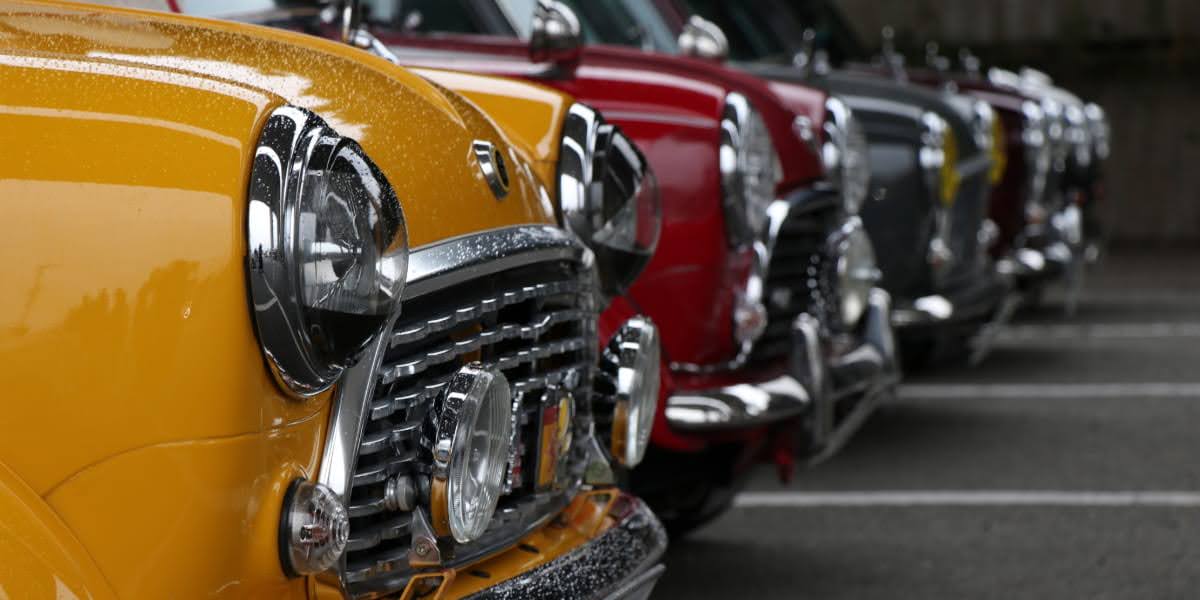The story of the original Mini Cooper is one of the most fascinating chapters in automotive history. Born from necessity during a fuel crisis and transformed into a racing legend, this iconic British car changed the way the world thinks about small vehicles. Understanding where it all began helps us appreciate why today’s Mini Cooper continues to capture hearts around the globe.
The original Mini Cooper wasn’t just a car – it was a revolution on wheels that proved big fun could come in small packages. From its humble beginnings in a Birmingham factory to becoming a motorsport champion, this little car’s legacy continues to influence modern automotive design and driving enjoyment.
The Crisis That Created a Legend
The original Mini Cooper story starts with a crisis that changed everything. In 1956, the Suez Crisis caused a severe fuel shortage across the United Kingdom. Gas rationing became a reality for British drivers, and suddenly those big, thirsty cars didn’t seem so appealing anymore.
Small European cars like the original Fiat 500 and German bubble cars started flying off dealer lots while large car sales crashed. Leonard Lord, the tough-talking boss of the British Motor Corporation (BMC), wasn’t about to let foreign cars take over his home market. He despised these tiny imports and set out to create what he called a “proper miniature car.”
Lord’s challenge was simple but demanding: create a car that would fit in a box measuring 10×4×4 feet, with 80% of that space devoted to passengers and luggage. It seemed impossible, but Lord had the perfect man for the job.
The Genius Behind the Design
Sir Alec Issigonis was already famous for designing the Morris Minor, but Lord’s new project would push his creativity to the limit. Issigonis was a brilliant engineer who thought outside the box – literally. He had to completely rethink how cars were built to meet Lord’s strict requirements.
Working with a small but talented team, Issigonis tackled the space problem with revolutionary solutions. He took BMC’s existing 848cc four-cylinder engine and did something nobody had tried before on a production car: he mounted it sideways (transversely) and put the transmission right in the oil sump underneath.
This brilliant layout freed up enormous space for passengers while keeping the car incredibly compact. Issigonis then pushed the wheels all the way out to the corners of the car, giving it amazing stability and that go-kart feeling that Mini drivers still love today.
The Mini Factory: Where History Was Made
The story of the original Mini Cooper can’t be told without understanding the mini factory where it all happened. The Longbridge plant in Birmingham became the beating heart of Mini production and one of the most important automotive facilities in British history.
Longbridge: From Tin Boxes to Automotive Icons
The mini factory at Longbridge had humble beginnings that nobody could have predicted would lead to automotive greatness. The site started in 1895 as a tin printing and box manufacturing works built by White and Pike Ltd. When that business failed in 1901, the factory sat empty for four years.
In 1905, a young entrepreneur named Herbert Austin bought the derelict facility for £7,500. Austin needed a place to build cars for his new company, The Austin Motor Company Ltd. Working frantically, his team built their first car in just two weeks to display at the 1905 Motor Show. Those first orders launched Longbridge’s incredible century-long career in car manufacturing.
By the time the original Mini Cooper arrived in 1959, Longbridge had grown into a massive industrial complex. The mini factory employed over 25,000 workers at its peak in the 1960s, making it one of the largest car plants in the world. The facility sprawled across multiple buildings and production areas, with the original South Works, followed by North Works, West Works, and East Works.
Production Begins: August 1959
The original Mini production assembly at Longbridge started in August 1959 and would continue virtually unchanged for over 40 years. The mini factory was a marvel of efficiency, with body shells dropping down onto engine and transmission packages in a flow-line assembly process that was ahead of its time.
What made the mini factory special wasn’t just its size or technology – it was the community it created. Workers proudly called it “The Austin,” and it became the center of life for thousands of Birmingham families. The factory built more than cars; it built relationships, skills, and a sense of pride that lasted generations.
The Birth of an Icon: 1959-1961
When the original Mini Cooper first rolled off the Longbridge production line, it was actually sold under two different names. BMC wanted to capitalize on brand loyalty from their recent merger, so the car appeared as both the Austin Seven and the Morris Mini-Minor.
The little car was an instant sensation, though it took some time for the public to fully understand what they were seeing. Here was a car that measured just 10 feet long but could comfortably seat four adults and still have room for luggage. The original Mini Cooper proved that clever engineering could beat brute force every time.
Technical Innovation That Changed Everything
The original Mini Cooper introduced several innovations that are now standard in modern cars:
- Transverse engine mounting: This sideways engine layout is now used in almost every front-wheel-drive car
- Front-wheel drive: While not the first, the Mini proved how effective this layout could be
- Rubber cone suspension: Alex Moulton’s compact suspension system saved space while providing excellent handling
- Wheels in the corners: Maximum wheelbase in minimum length for better stability and interior room
These innovations weren’t just clever engineering tricks – they fundamentally changed how the automotive industry thought about small car design. The original Mini Cooper proved that economy cars didn’t have to be compromise-mobiles.
John Cooper Enters the Story
The transformation from practical city car to performance legend began in 1961 when racing car constructor John Cooper saw the Mini’s potential. Cooper was already famous for building Formula One cars, and he immediately recognized that the Mini’s excellent balance and lightweight construction could make it a formidable competitor.
BMC was initially skeptical about creating a performance version. As far as they were concerned, the Mini was supposed to be an affordable, practical small car – not a sports car. But Cooper’s persistence paid off, and in 1961, the first original Mini Cooper was born.
The Racing Transformation
The original Mini Cooper featured several crucial improvements over the standard Mini:
- More powerful 997cc engine: Producing 55 horsepower at 6,000 rpm
- Front disc brakes: Revolutionary stopping power for such a small car
- Improved suspension tuning: Better handling for spirited driving
- Top speed of 87 mph: Impressive performance for the era
The success was immediate. Even the first version saw more than 12,000 units produced by 1964, proving that people wanted an affordable sports car that was practical enough for daily use.
Racing Glory and the Cooper S Legacy
Encouraged by the success of the original Cooper, BMC launched an even more potent version in March 1963: the Mini Cooper S. This model was developed specifically with motorsport in mind and featured a larger 1071cc engine producing 70 horsepower at 6,200 rpm.
The Cooper S introduced several racing-inspired features:
- Additional oil cooler: For sustained high-performance driving
- Twin fuel tanks: Better weight distribution and longer range
- Servo-assisted disc brakes: Improved stopping power for racing
- Distinctive perforated wheels: Lightweight alloys that became iconic
Monte Carlo Domination
The original Mini Cooper and Cooper S models achieved their greatest fame on the rally stages of Europe. Between 1964 and 1967, Minis won the prestigious Monte Carlo Rally three times, establishing the car’s reputation as a giant-killer that could outhandle much larger, more powerful competitors.
The 1966 Monte Carlo Rally became legendary for all the wrong reasons. Mini-Coopers finished the rally in a smashing 1-2-3 position, but unfortunately, the organizers had imposed a draconian new rule for that year, stating the cars must be 100% factory original. After extensive inspection, officials disqualified all three winning Minis because their headlight bulbs had been replaced with more powerful ones.
The controversy sparked outrage from drivers, team managers, fans, and the press, but the decision stood. Ironically, this “defeat” only added to the Mini Cooper legend, showing that the little British car was so dominant that competitors had to resort to technicalities to stop it.
Manufacturing Excellence at the Mini Factory
The success of the original Mini Cooper was only possible because of the manufacturing excellence achieved at the mini factory in Longbridge. By the 1960s, this incredible facility was churning out over 200,000 cars per year, making it one of the most productive car plants anywhere in the world. But how did they do it, and what made this place so special?
What Made the Mini Factory So Revolutionary?
The mini factory at Longbridge wasn’t just big – it was smart. The engineers and managers there figured out ways to build cars faster and better than anyone had done before. They also made production more efficient than previous methods. Think of it like a perfectly choreographed dance. Every worker, machine, and part knew exactly where to be and when.
How did they build so many cars so quickly? The secret was in their innovative production techniques. Other car companies around the world started copying these methods:
- Flow-line assembly: Car bodies moved smoothly from one station to the next. This was like items on a conveyor belt at the grocery store checkout, but much more complex.
- Integrated sub-assembly: Workers didn’t install every single part one by one. Instead, they would pre-build entire engine packages. Then they could drop them into the car all at once.
- Quality control systems: Every car got checked multiple times during production. This caught problems early, not after the customer bought it
- Just-in-time components: Parts arrived exactly when needed, so the factory didn’t waste money storing tons of extra stuff
The Human Side of Production
What was it like to work there? Workers at the mini factory weren’t just doing a job – they were part of something special. The pride they felt was real and contagious. Picture this amazing moment: in May 1969, when the two-millionth Mini rolled off the production line, workers actually cheered and celebrated. George Turnbull, the big boss of Austin Morris division, sat in that historic car right next to Alec Issigonis, the genius who designed the original Mini.
This wasn’t just a photo opportunity – it showed how connected everyone felt to the cars they were building. Over 25,000 people worked at Longbridge during its peak years. For many Birmingham families, working at “The Austin” (as locals called it) was a tradition passed down from parents to children.
What made the work environment special?
- Job security: Families could count on steady work for generations
- Skill development: Workers learned valuable manufacturing skills that lasted a lifetime
- Community pride: The whole city of Birmingham was proud of what they built
- Innovation culture: Workers were encouraged to suggest improvements and solutions
Going Global: The Mini Factory Network
Why did Mini need factories around the world? As the original Mini Cooper became more popular, demand grew so fast that one factory couldn’t keep up. Plus, shipping cars across oceans was expensive, and many countries had high taxes on imported cars.
The solution was brilliant: build Mini factories everywhere people wanted the cars. The main mini factory in England worked with plants in:
- Australia: Built right-hand drive versions for the Australian market
- Spain and Italy: Served European customers who wanted to avoid import taxes
- South America: Countries like Chile and Uruguay got their own Mini production
- Africa: South African factories built Minis for the local market
How did they keep quality consistent across different countries? This was a huge challenge. Each local factory had to:
- Follow exact blueprints: Every Mini had to meet the same standards, no matter where it was built
- Use approved suppliers: Parts had to come from companies that met BMC’s strict requirements
- Train workers properly: Local workers learned the same techniques used at Longbridge
- Regular inspections: BMC sent experts to check that quality stayed high
The Numbers That Tell the Story
Just how successful was the mini factory network? The numbers are pretty amazing:
- 41 years of production: From 1959 to 2000, longer than most people’s entire careers
- 5.3 million cars built: More than the population of many countries
- Multiple continents: Minis were built on every continent except Antarctica
- Local adaptation: Each market got features that made sense for local conditions
What happened to all these factories? Some continued building other cars after Mini production ended, while others were converted to different uses. The original Longbridge mini factory closed in 2005, but parts of it are still used for car development work today.
The global success of the original Mini Cooper proved that great design combined with smart manufacturing could create something truly special. These factories didn’t just build cars – they built a worldwide community of Mini lovers who still gather at car shows and clubs today, sharing stories about their beloved little British cars.
Cultural Impact Beyond the Factory Gates
The original Mini Cooper quickly transcended its role as simple transportation to become a cultural icon. In the swinging sixties, celebrities and pop stars were frequently photographed with their Minis, helping establish the car as a symbol of youth, creativity, and rebellion against conformity.
The car’s appearance in films like “The Italian Job” cemented its place in popular culture. Those famous chase scenes through Turin, with Minis racing through sewers and jumping across rooftops, showed the world what the little car could do when pushed to its limits.
Building a Community
The mini factory wasn’t just manufacturing cars – it was building a community. The factory has been a major employer and an integral part of the local community since its foundation. Longbridge employed generations of Birmingham families, with skills and traditions passed down from parents to children.
This community aspect extended to Mini owners worldwide. The original Mini Cooper created a global family of enthusiasts who shared a passion for the car’s unique character. Club meetings, rallies, and races brought together people from all walks of life united by their love for these special little cars.
Legacy and Influence on Modern Design
The innovations pioneered by the original Mini Cooper continue to influence automotive design today. The transverse engine layout developed for the Mini is now used in virtually every front-wheel-drive car on the road. The emphasis on maximizing interior space within a compact footprint remains a primary goal for modern city cars.
Lessons That Endure
The original Mini Cooper taught the automotive industry several crucial lessons:
- Space efficiency matters more than overall size: Clever packaging can create surprising interior room
- Handling trumps horsepower: A well-balanced car with good suspension is more fun than a powerful but clumsy one
- Character sells cars: Vehicles with personality create emotional connections with buyers
- Innovation requires courage: Sometimes the best solutions come from completely rethinking conventional approaches
From Factory Floor to Modern Icon
The classic Mini was introduced to the world in 1959. It had an astonishing production run of 41 years. The final tally reached over 5 million units, making it the most popular British car ever produced.
Production ended in October 2000. This marked the end of original Mini production after 41 years. It also brought about the demise of the 1275 cc engine. This engine had powered the Mini and numerous other BL/BMC/ARG cars for more than 35 years.
The last original Mini Cooper to roll off the Longbridge production line was a red Cooper Sport in October 2000. It marked the end of an era, but also the beginning of a new chapter as BMW prepared to launch their interpretation of the Mini concept.
The Enduring Appeal
What made the original Mini Cooper special wasn’t just its clever engineering or racing success – it was the way it made people feel. Drivers consistently described the experience as being like driving a go-kart, with immediate steering response, playful handling, and a sense of connection between car and driver that’s rare in any era.
This emotional connection explains why the Mini name remains so powerful today. When BMW revived the brand in 2001, they understood that they weren’t just building a new small car – they were carrying forward the legacy of one of the most beloved automobiles ever created.
Your Connection to Mini Legacy
The story of the original Mini Cooper and the mini factory where it was born reminds us that great cars are more than just transportation – they’re expressions of creativity, engineering excellence, and human passion. From Sir Alec Issigonis’s revolutionary design to John Cooper’s racing modifications to the skilled workers at Longbridge who built millions of these special cars, the Mini story is ultimately about people pursuing excellence.
Today’s Mini Cooper carries that same spirit of innovation and fun that made the original Mini Cooper such a phenomenon. While the technology has advanced and the cars have grown larger, the essential character remains: maximum enjoyment from minimal size, handled with distinctly British flair.
Ready to become part of the continuing Mini Cooper story? Contact Braman Mini of Palm Beach to explore how today’s Mini models honor the legacy of the original Mini Cooper while delivering modern performance, safety, and technology. Our team understands the heritage behind every Mini and can help you find the perfect model to continue your own chapter in this remarkable automotive legacy.






